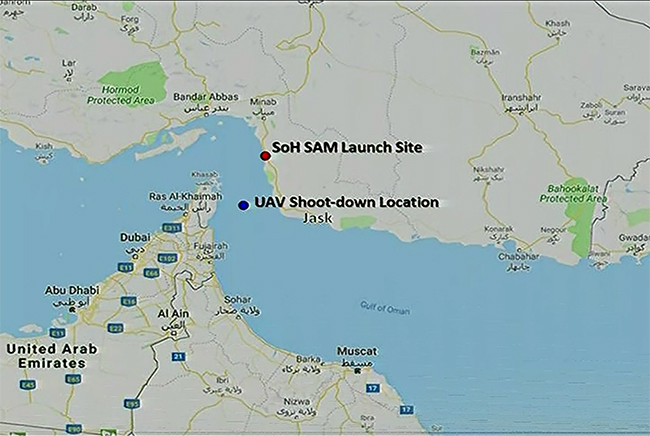
The map above, which was displayed during a Pentagon press briefing about the attack, pinpoints where the US drone was shot down. DOD video screenshot.
An Iranian surface-to-air missile shot down a US drone over the Strait of Hormuz around 11:35 p.m. GMT on June 19, US Central Command spokesman Navy Capt. Bill Urban said in a statement.
Iran’s Revolutionary Guard Corps said the remotely piloted aircraft was shot down over Iranian airspace and the spokesman for Iran’s foreign ministry called it an “illegal trespassing and invading of the country’s skies,” according to the Associated Press. But? Urban said the US Navy’s Broad Area Maritime Surveillance (BAMS-D) aircraft—an RQ-4A? Global Hawk High-Altitude Long Endurance unmanned aircraft system used for intelligence, surveillance, and reconnaissance operations—was operating in international airspace at the time.
This Defense Department video shows the smoke trail left after a US Global Hawk unmanned aerial vehicle was shot down over the Gulf of Oman on June 18, 2019. Video: DOD
“This was an unprovoked attack on a US surveillance asset that had not violated Iranian airspace at any time during its mission,” Air Forces Central Command boss Lt. Gen. Joseph Guastella said in a statement. “Iranian reports that this aircraft was shot down over Iran are catagorically false.”
Guastella said the aircraft was operating at high altitude, 34 kilometers from the “nearest point of land on the Iranian coast,” when it was shot down over the Strait of Hormuz, falling into international waters.
“This dangerous and escalatory attack was irresponsible and occurred in the vicinity of established air corridors between Dubai, United Arab Emirates, and Muscat, Oman, possibly endangering innocent civilians,” Guastella added.
To support Guastella’s remarks, Central Command on Twitter posted a map of the aircraft’s flight ?path.
?However, Iranian Foreign Minister Javad Zarif said in a June 20 tweet that sections of the downed drone have been retrieved from the nation’s waters.
That tweet was accompanied by two maps: a hand-drawn one that outlines what they say was the US drone’s flight path—beginning at a misspelled Al Dhafra Air Base—and the other seemingly a screenshot from Google.
Zarif said the nation doesn’t “seek war” with the US, but promised it would “zealously defend” its airspace, ground territory, and waters in response to what it called “economic terrorism” and “covert action” the US has allegedly carried out against the country.
In a video also tweeted on June 20, Israeli Prime Minister Benjamin Netanyahu called for “all peace-loving countries to stand by the United States in its effort to stop Iranian aggression,” and said his nation “stands by the United States on this.”
The news comes just days after CENTCOM said Iran unsuccessfully tried to shoot down another US drone over the Gulf of Oman. US officials also believe Iran assisted the Houthis in a June 6 attack on an MQ-9 over Yemen that was successful.
“Iran made a very big mistake!” tweeted President Donald Trump on June 20, though he offered no additional details.
The United States has been bolstering its presence in the Middle East over the last couple of weeks in response to what the White House and Defense Department say are increased threats emanating from Iran. Four F-15E Strike Eagles from the 4th Fighter Wing at Seymour Johnson AFB, N.C., joined a contingent of F-15Cs and F-35 strike fighters at Al Dhafra AB, UAE, on June 13. The Pentagon also recently announced the US would soon be sending unnamed intelligence, surveillance, and reconnaissance aircraft to the region.
The US military buildup in the region began last month with the deployments of a B-52 Bomber Task Force, the USS Abraham Lincoln Carrier Strike Group, and other assets to the US Central Command region.